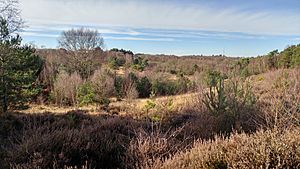Castle Bottom NNR facts for kids
Castle Bottom is a special place in the UK, a bit like a protected park for nature. It's called a national nature reserve and you can find it near a town called Yateley in Hampshire. This reserve is also part of a bigger area known as Castle Bottom to Yateley and Hawley Commons. This larger area is important enough to be called a Site of Special Scientific Interest because of its unique plants and animals. It's also part of the Thames Basin Heaths Special Protection Area, which helps protect wild birds.
Contents
Exploring Castle Bottom
Castle Bottom nature reserve is located southwest of Yateley. It sits right next to the northwest edge of Blackbushe Airport. This reserve is a small area, about 29 hectares (which is like 71 acres). It has two special wet areas called valley mires. These mires are like marshy, boggy lands. The reserve also has dry heathland and woodland areas. Each of the valley mires has a small, acidic stream flowing through it.
A Look Back in Time
People have used the Castle Bottom area for a very long time. We know this because ancient burial mounds have been found there. These mounds show that humans were living in the area between 1800 and 550 BC. There's also evidence of banks built in the Western Mire. However, nobody knows exactly when these banks were made.
The land used to belong to a large estate called Bramshill House. But in 1952, it was sold. Before the local council bought the site, it was owned by a company that made quarry equipment.
In the early 1900s, two small cottages were built on the northern edge of the reserve. People lived in these cottages until the 1960s. Now, they are just ruins.
Amazing Animals of Castle Bottom
Castle Bottom is home to many different kinds of animals. Here are some of them:
Mammals
- Exmoor pony
- European water vole
- European badger
- Common noctule (a type of bat)
- Common pipistrelle (another type of bat)
Birds
- African stonechat
- Woodlark
- European nightjar
- Dartford warbler
- Eurasian hobby
- Willow warbler
- Garden warbler
- Eurasian sparrowhawk
- Eurasian woodcock
- European turtle dove
- Lesser spotted woodpecker
- Tree pipit
- Song thrush
- Eurasian woodcock
- Goldcrest
- Common linnet
- Eurasian curlew
- Northern lapwing
- Common snipe
- Common swift
- Common kestrel
Invertebrates
Invertebrates are animals without a backbone, like insects and spiders. Castle Bottom has many interesting ones:
- Dragonfly
- Damselfly
- Ectobius lapponicus
- Ectobius panzeri
- Silver-studded blue (a butterfly)
- Myopa fasciata
- Chrysomela populi
- Large skipper (a butterfly)
- Apatura iris
- Tethea or
- Pachycnemia hippocastanaria
- Polia hepatica
- Parascotia fuliginaria
- Ancylis upupana
- Eucosma conterminana
- Calamotropha paludella
- Crambus hamella
- Elaphria venustula
- Chrysis fulgida
- Symmorphus crassicornis
- European beewolf
- Andrena congruens
- Andrena florea
- Hydaticus seminiger
- Helochares punctatus
- Thomisus onustus
- Philodromus albidus
- Marpissa muscosa
- Aelurillus v-insignitus
- Xerolycosa nemoralis
- Zilla diodia
- Hypsosinga sanguinea
Reptiles, Amphibians, and Other Vertebrates
These are animals with backbones, like snakes, frogs, and fish.
- Grass snake
- Vipera berus (a type of snake)
- Viviparous lizard
- Anguis fragilis (also known as a slow worm)
- Common frog
- Common toad
- Brown trout (a fish)
Fungi
Fungi are a kingdom of life that includes mushrooms and molds.
- Morchella elata
- Typhula quisquiliaris
- Inonotus radiatus
- Schizophyllum commune
- Tricholoma cingulatum
- Panellus serotinus
- Lactarius pubescens
- Leccinum holopus
- Tremella foliacea
- Pisolithus arhizus
Wonderful Plants of Castle Bottom
The reserve is also home to many different types of plants, known as flora.
Trees
- Conifer trees (like pine trees)
- Scots pine
- Silver Birch
Herbaceous Plants
These are plants that are not woody, like many flowers and grasses.
- Cuscuta epithymum
- Gnaphalium sylvaticum
- Hyacinthoides non-scripta (also known as bluebell)
- Narthecium ossifragum
- Ulex minor
- Calluna (heather)
- Erica cinerea (bell heather)
- Erica tetralix (cross-leaved heath)
- Pteridium aquilinum (bracken)
- Ulex europaeus (gorse)
- Agrostis curtisii
- Moenchia erecta
- Botrychium lunaria
- Cirsium dissectum
- Myrica gale
- Rhynchospora alba
- Drosera rotundifolia (round-leaved sundew)
- Drosera intermedia (oblong-leaved sundew)
- Anagallis tenella
- Centaurium erythraea
- Lotus corniculatus
- Polygala


